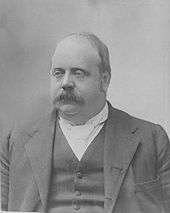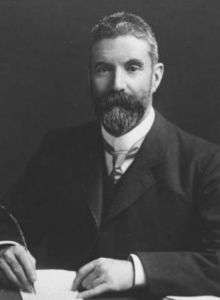Australian federal election, 1906
| | |||||||||||||||||||||||||||||||||||||||||||||||||||||||||||
| |||||||||||||||||||||||||||||||||||||||||||||||||||||||||||
| |||||||||||||||||||||||||||||||||||||||||||||||||||||||||||
| |||||||||||||||||||||||||||||||||||||||||||||||||||||||||||
Federal elections were held in Australia on 12 December 1906. All 75 seats in the House of Representatives, and 18 of the 36 seats in the Senate were up for election. The incumbent Protectionist Party minority government led by Prime Minister of Australia Alfred Deakin retained government, despite winning the least amount of House of Representatives votes and seats of the three parties, with the parliamentary support of the Labour Party led by Chris Watson, while the Anti-Socialist Party (renamed from the Free Trade Party) led by George Reid remained in opposition.
Watson resigned as Labour leader in October 1907 and was replaced by Andrew Fisher. The Protectionist minority government fell in November 1908 to Labour, a few days before Reid resigned as Anti-Socialist leader, who was replaced by Joseph Cook. The Labour minority government fell in June 1909 to the newly formed Commonwealth Liberal Party led by Deakin. The party was formed on a shared anti-Labour platform as a merger between Deakin, leader of the Protectionists, and Cook, leader of the Anti-Socialists, in order to counter Labour's growing popularity. The merger didn't sit well with several of the more liberal Protectionists, who defected to Labour or sat as independents.
The merger would allow the Deakin Commonwealth Liberals to construct a mid-term parliamentary majority, however less than a year later at the 1910 election, Labour won both majority government and a Senate majority, representing a number of firsts: it was Australia's first elected federal majority government, Australia's first elected Senate majority, the world's first Labour Party majority government at a national level, and after the 1904 Watson minority government the world's second Labour Party government at a national level. The 113 acts passed in the second Fisher government (1910–13) exceeded even the output of the second Deakin government over a similar period. At the time, it represented the culmination of Labour's involvement in politics. It was a period of reform unmatched in the Commonwealth until the 1940s under John Curtin and Ben Chifley.
Results
| Party | Votes | % | Swing | Seats | Change | Notes | |
|---|---|---|---|---|---|---|---|
| Anti-Socialist Party | 363,257 | 38.17 | +3.80 | 26 | +2 | (3 elected unopposed) | |
| Federal Labour Party | 348,711 | 36.64 | +5.69 | 26 | +3 | (3 elected unopposed) | |
| Protectionist Party | 156,425 | 16.44 | -13.26 | 16 | -10 | (1 elected unopposed) | |
| Ind Protectionist | 46,074 | 4.84 | * | 5 | +5 | ||
| Western Australian Party | 22,154 | 2.33 | * | 1 | +1 | ||
| Independents/Other | 15,067 | 1.58 | −2.91 | 1 | 0 | ||
| Total | 951,688 | 75 | |||||
| Labour/Protectionist | WIN | 42 | −7 | ||||
| Anti-Socialist Party | 26 | +2 | |||||
Independent: Frederick Holder (Wakefield, SA)
| Party | Votes | % | Swing | Seats Won | Seats Held | Change | |
|---|---|---|---|---|---|---|---|
| Anti-Socialist Party | 1,384,662 | 46.53 | +12.20 | 11 | 14 | +2 | |
| Federal Labour Party | 1,152,517 | 38.73 | +8.98 | 5 | 15 | +1 | |
| Protectionist Party | 369,308 | 12.41 | −5.12 | 2 | 6 | −2 | |
| Independents | 26,771 | 0.90 | −11.84 | 0 | 1 | 0 | |
| Other | 42,292 | 1.42 | +1.42 | 0 | 0 | −1 | |
| Total | 2,975,550 | 18 | 36 | ||||
Independent: William Trenwith (Vic)
Significance
It was the third federal election in Australia following the adoption of the federal government. The election was largely important as it would demonstrate which of the parties (if any) could hold together a stable government after the unstable second term of the previous one, which saw four different governments in power. It would also see if all parties could survive the implementation of protectionist policies which differentiated the two. This was also the first election where all seats for the House of Representatives were voted for via a First-past-the-post system (at previous elections some states voted as one electorate, using a bloc vote), and the first time that Tasmania was divided into separate electorates. The election result was the continuation of a Protectionist government led by Deakin and supported by Labour, which remained in power largely due to the unwillingness of the Anti-Socialist Party to support a vote of no confidence against it.
George Reid adopted a strategy of trying to reorient the party system along Labour vs non-Labour lines – before the election, he renamed his Free Trade Party to the Anti-Socialist Party. Reid envisaged a spectrum running from socialist to anti-socialist, with the Protectionist Party in the middle. This attempt struck a chord with politicians who were steeped in the Westminster tradition and regarded a two-party system as very much the norm.[1]
Since the Protectionist primary platform of government tariffs had been dealt with by previous governments, the party had become somewhat redundant. Those who remained were largely supporting the Party's leader, Alfred Deakin, rather than its policies. Of the three, the Labour Party, led by Chris Watson, now had the most realistic chance of becoming the dominant party after their gains in the 1903 election and after their leading status in the four minor states they were looking to make the same type of gains in Victoria and New South Wales.
The first federal referendum in Australia's history was held in conjunction with the election. The proposed alteration to the Constitution, to change the start date of Senators' terms from 1 January to 1 July, passed in all states and was carried.
Seats changing hands
| Seat | Pre-1906 | Swing | Post-1906 | ||||||
|---|---|---|---|---|---|---|---|---|---|
| Party | Member | Margin | Margin | Member | Party | ||||
| Balaclava, Vic | Protectionist | George Turner | 100.0 | 41.8 | 4.0 | Agar Wynne | Independent | ||
| Barker, SA | Protectionist | Langdon Bonython | 100.0 | 58.1 | 8.1 | John Livingston | Anti-Socialist | ||
| Batman, Vic | new division | 1.7 | Jabez Coon | Protectionist | |||||
| Bendigo, Vic | Protectionist | John Quick | 1.1 | 51.7 | 1.7 | John Quick | Independent | ||
| Brisbane, Qld | Labour | Millice Culpin | 2.1 | 13.4 | 11.3 | Justin Foxton | Anti-Socialist | ||
| Capricornia, Qld | Labour | David Thomson | 9.6 | 15.2 | 5.6 | Edward Archer | Anti-Socialist | ||
| Cowper, NSW | Anti-Socialist | Henry Lee | 13.0 | 13.9 | 0.9 | John Thomson | Protectionist | ||
| Denison, Tas | Protectionist | Philip Fysh | 0.2 | 15.1 | 10.5 | Philip Fysh | Anti-Socialist | ||
| Fawkner, Vic | new division | 13.9 | George Fairbairn | Independent | |||||
| Franklin, Tas | Revenue Tariff | William McWilliams | 4.6 | 100.0 | 100.0 | William McWilliams | Anti-Socialist | ||
| Fremantle, WA | Labour | William Carpenter | 11.3 | 12.2 | 0.9 | William Hedges | Western Australian | ||
| Grey, SA | Anti-Socialist | Alexander Poynton | 100.0 | 100.0 | 100.0 | Alexander Poynton | Labour | ||
| Indi, Vic | Protectionist | Isaac Isaacs | 100.0 | 44.4 | 2.7 | Joseph Brown | Anti-Socialist | ||
| Macquarie, NSW | Anti-Socialist | Sydney Smith | 4.0 | 51.3 | 1.3 | Ernest Carr | Labour | ||
| Maribyrnong, Vic | new division | 6.9 | Samuel Mauger | Protectionist | |||||
| Melbourne Ports, Vic | Protectionist | Samuel Mauger | 6.8 | 9.4 | 2.6 | James Mathews | Labour | ||
| Indi, Vic | Independent | James Wilkinson | 5.8 | 18.3 | 12.5 | Hugh Sinclair | Anti-Socialist | ||
| New England, NSW | Anti-Socialist | Edmund Lonsdale | 1.9 | 51.8 | 1.8 | Francis Foster | Labour | ||
| Oxley, Qld | Protectionist | Richard Edwards | 2.3 | 14.3 | 16.6 | Richard Edwards | Anti-Socialist | ||
| South Sydney, NSW | Anti-Socialist | George Edwards | 6.0 | 12.4 | 6.4 | Chris Watson | Labour | ||
| Wannon, Vic | Anti-Socialist | Arthur Robinson | 2.9 | 5.7 | 2.8 | John McDougall | Labour | ||
| Werriwa, NSW | Anti-Socialist | Alfred Conroy | 18.7 | 20.5 | 1.8 | David Hall | Labour | ||
| Wimmera, Vic | Protectionist | Pharez Phillips | 0.1 | 14.6 | 14.2 | Sydney Sampson | Independent | ||
- Members in italics did not contest their seat at this election.
Post-election pendulum
See also
- Candidates of the Australian federal election, 1906
- Members of the Australian House of Representatives, 1906–1910
- Members of the Australian Senate, 1907–1910
Notes
References
- University of WA election results in Australia since 1890


